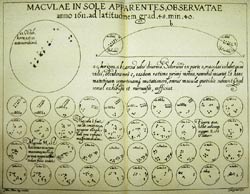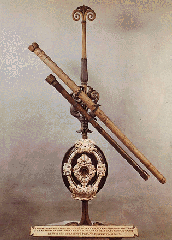
Sun-Earth Day Presents: Eclipse, In a Different Light
How could a Perfect Orb like the sun have blemishes? Some early observations of sunspots spawned two radically different opinions on this matter.
TECHNOLOGY THROUGH TIME ISSUE #31: Galileo Galilei

Using telescopes similar to Galileo Galilei's instrument, Johannes Fabricius and Christoph Scheiner began the first systematic study of sunspots in early 1611. Johannes Fabricius was the first to publish his observations in De Maculis in Sole Observatis ("On the Spots Observed in the Sun") in 1611, but it remained unknown to the other observers for some time. Scheiner's book Tres Epistolae de Maculis Solaribus Scriptae ad Marcum Welserum ("Three Letters on Solar Spots written to Marc Welser") appeared in 1612.
Scheiner wanted to preserve the unblemished perfection of the sun, and proposed that sunspots were simply satellite orbiting the sun. In 1612, Galileo was equally certain that sunspots were on the surface of the sun, or at least that they could be clouds in the solar atmosphere, and published his first drawings of them in his 1613 book ' Istoria e Dimostrazioni intorno alle Macchie Solari' (Letters on Sunspots to Marc Welser), which was basically an answer to Scheiner's hypothesis. After a series of lengthy letter exchanges and debates, Scheiner eventually backed away from his assertion of solar satellites, and Galileo's interpretation prevailed.

In his famous book on optics, 'Rosa Ursina' , Scheiner published many more detailed observations of sunspots like the one above, and no longer described sunspots as satellites. This book became a standard 'textbook' on sunspots for over a century. However, as the sun entered the Maunder Minimum (1645-1710), very few sunspots were seen, and they were only sporadically reported by observer's diligent attempts to observe them.
Technology Through Time
ISSUES
- #46: The Magnetic Sun
- #45: Coronagraph
- #44: Einstein
- #43: Coronium
- #42: The Sun - In a Different Light
- #41: Gallery of Drawings
- #40: First Sun Photo
- #39: Solar Spectroscopy
- #38: George Ellery Hale
- #37: Coronal Mass Ejections
- #36: First Corona Descriptions
- #35: First Sunspot Drawing
- #34: Ptolemy
- #33: Ancient Greece
- #32: Ancient Babylon
- #31: Galileo Galilei
Eclipse Fact
The width of the Moon's shadow is at most 170 miles wide.



